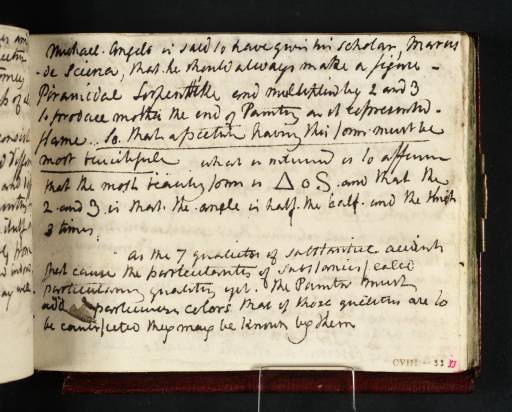Joseph Mallord William Turner Inscription by Turner: Notes on Proportion, from Giovanni Paolo Lomazzo c.1809
Joseph Mallord William Turner,
Inscription by Turner: Notes on Proportion, from Giovanni Paolo Lomazzo
c.1809
Joseph Mallord William Turner 1775–1851
Folio 33 Recto:
Inscription by Turner: Notes on Proportion, from Giovanni Paolo Lomazzo circa 1809
D07407
Turner Bequest CVIII 33
Turner Bequest CVIII 33
Pen and ink on white wove paper, 88 x 115 mm
Inscribed by Turner in ink (see main catalogue entry)
Inscribed by John Ruskin in red ink ‘33’ bottom right
Stamped in black ‘CVIII – 33’ bottom right
Inscribed by Turner in ink (see main catalogue entry)
Inscribed by John Ruskin in red ink ‘33’ bottom right
Stamped in black ‘CVIII – 33’ bottom right
Accepted by the nation as part of the Turner Bequest 1856
References
1909
A.J. Finberg, A Complete Inventory of the Drawings of the Turner Bequest, London 1909, vol.I, p.289, CVIII 33, as ‘Notes on perspective and painting’.
1969
John Gage, Colour in Turner: Poetry and Truth, London 1969, pp.109, 249 note 179.
1984
Jerrold Ziff, ‘Turner, the Ancients, and the Dignity of the Art’, Turner Studies, vol.3, no.2, Winter 1984, p.49 notes 6 and 7.
1994
Maurice William Davies, ‘J.M.W. Turner’s Approach to Perspective in his Royal Academy Lectures of 1811’, unpublished Ph.D thesis, Courtauld Institute of Art, London 1994, p.288.
The whole page is taken up with the following notes:
Michael. Angelo is said to have given his scholar, Marus [Lomazzo: ‘Marcus’] | de Sciena, that he should always make a figure – | Piramidal Serpentlike and multiplied by 2 and 3 | to produce motion the end of Painting as it represented | flame so that a picture having this form must be | most beautifull what is intended is to affirm | that the most beauty form is ¿ o S and that the | 2 and 3 is that the angle is half the half and the High | 3 times
As the 7 qualities of substantial accidents | that cause the particularities of substances calld | particularizing qualities yet. The Painter must | add <ad> particular[?ized] colors that if those qualities are to | be counterfeited they may be known by them
John Gage and Jerrold Ziff have identified these notes, continuing opposite from folio 32 verso (D07406), as free transcriptions from the 1598 English edition of Giovanni Paolo Lomazzo’s Tracte Containing the Artes of Curious Paintinge Carvinge & Buildinge (see the sketchbook Introduction).1 Turner’s first paragraph is taken from page 17 and the second from page 18 in chapter I, ‘The Definition of Painting’, of ‘The First Booke of the Naturall and Artificiall Proportion of Things’; the passage on Michelangelo appears in Turner’s manuscripts for his Royal Academy perspective lectures.2
On page 17, Lomazzo refers to proportions
multiplied by one two and three. In which precept (in mine opinion) the whole mysterie of the arte consisteth. ... Nowe there is no forme so fitte to express this motion, as that of the flame of fire. Which according to Aristotle and the other Philosophers, is an element most active of all others: because the forme of the flame thereof is most apt for motion: for it hath a Conus or sharpe pointe wherewith it seemeth to divide the aire, that so it may ascende to his proper sphere. So that a picture having this forme will bee most beautifull.
He continues: ‘... it shoulde resemble the form of the letter S placed right, or else turned the wronge way, as [printed ‘S’ rotated ninety degrees anticlockwise]; because then it hath his beauty’. He attempts to clarify Michelangelo’s system of proportion: ‘For the Diameter of the biggest place, betweene the knee and the foote is double to the least, and the largest part of the thigh triple’.
In a passage on page 18 concerning the representation of an individual figure or portrait, Lomazzo declares : ‘... variety is caused by those 7. particularities which the Philosophers call *particularizing qualities, that is *7 substantiall accidents which cause the particularity and singularity of substances’. As John Gage observes, Turner ‘conflated Lomazzo’s phrase’,3 which is also qualified by two marginal notes indicated by asterisks, respectively the Latin phrase ‘Individuandtes qualitates’ and ‘Forme, figure, place, stocke, name, country, time’. The passage continues: ‘when unto this proportioned quality he shall further add colour, then he giveth the last forme & perfection to the figure... And to conclude the picture will attaine to such perfection, that the party counterfeited may easily bee known thereby’.
Further passages of Turner’s extensive notes from Lomazzo appear later in the sketchbook, continuing on the verso of the present leaf (D07408).
Matthew Imms
June 2008
How to cite
Matthew Imms, ‘Inscription by Turner: Notes on Proportion, from Giovanni Paolo Lomazzo c.1809 by Joseph Mallord William Turner’, catalogue entry, June 2008, in David Blayney Brown (ed.), J.M.W. Turner: Sketchbooks, Drawings and Watercolours, Tate Research Publication, December 2012, https://www

